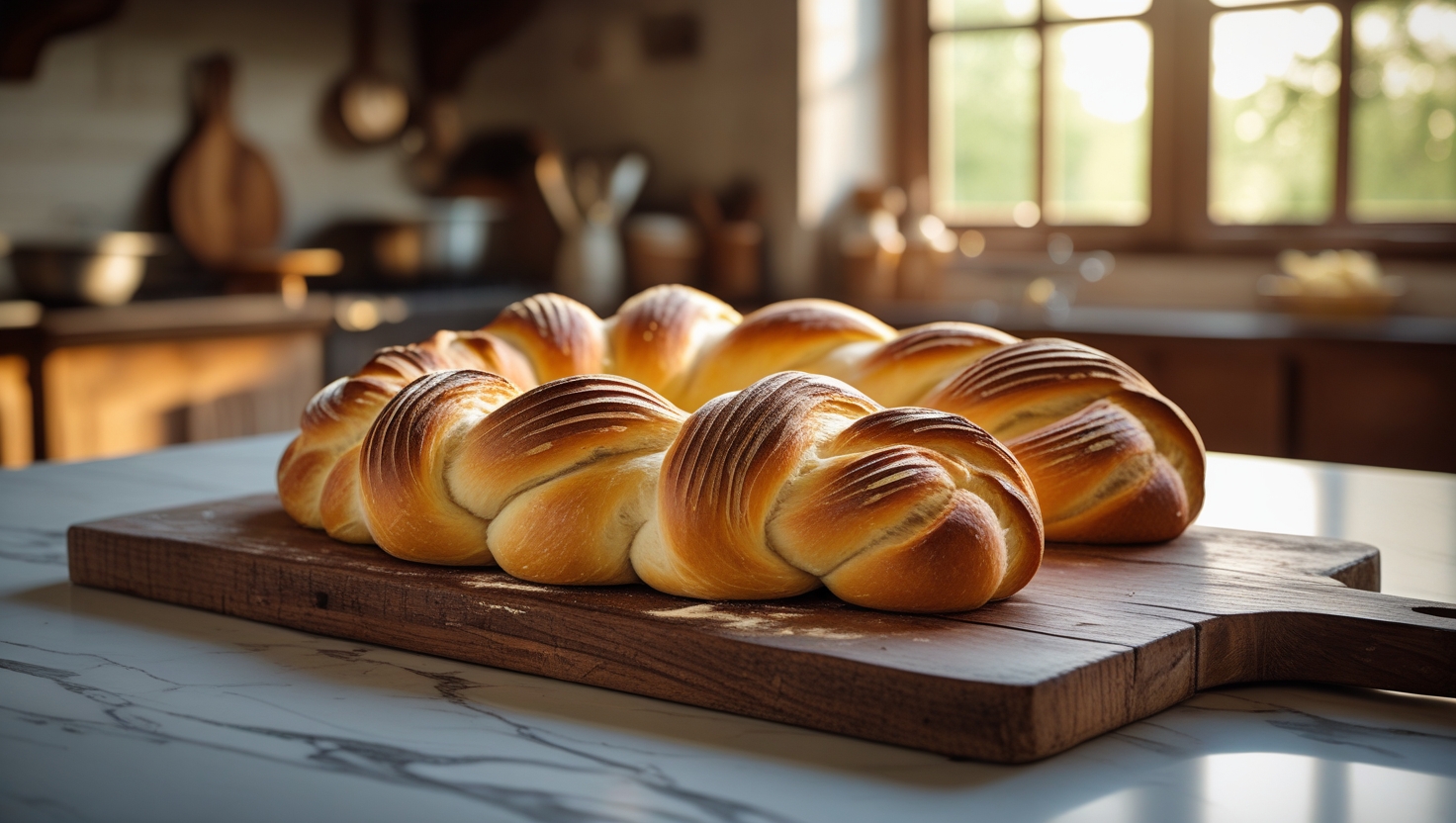INTRODUCTION
Braided bread is more than just a beautiful loaf. It is a symbol of warmth, tradition, and homemade comfort. This simple recipe shows you how to create two golden braided loaves using basic pantry ingredients. Whether you are just starting out or already love to bake, you will learn how to mix, knead, and shape dough into soft, impressive braids. In this article, I will guide you through every step, share the roots of this bread style, and explain how to serve it well. You will also hear a story from my bakery, Lila’s Table, where braided bread is always a favorite.
Table of Contents
Table of Contents
The Story Behind Braided Bread – Why It Matters
A Family Tradition in Every Braid
I first learned to braid bread in my grandmother’s kitchen in Asheville. She was Greek and full of warmth, and her hands moved with ease through bowls of flour and warm milk. Whenever she made tsoureki, she let me roll the dough into ropes. I would cross each strand with care while she reminded me to keep it light and even. It felt like we were weaving something more than just bread. We were creating memories, one strand at a time.
Years later, when I lived in Cebu, I tasted a local pan de leche that was soft and sweet, and it brought me back to that moment. It reminded me how braided breads are part of so many cultures, each with its own flavor and meaning. That’s when I knew I wanted to make it a part of my work at Lila’s Table.
Now, braided bread is one of the quiet stars in my bakery. We serve it at brunch with citrus butter and alongside dinner spreads with infused oils.This is the type of bread that brings people together, perfect for tearing apart and sharing. That’s what bread is all about.
Print
Braided Bread Recipe – Soft, Golden Loaves Anyone Can Master
- Total Time: 2 hours 30 minutes
- Yield: 24 slices 1x
Description
A simple, step-by-step recipe for baking two stunning braided loaves with a perfectly golden finish.
Ingredients
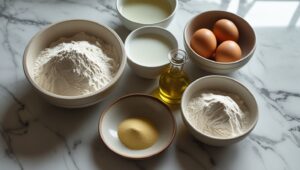
2 cups warm milk divided
1.5 tbsp yeast
1 tsp sugar
1 tsp salt
4.5 cups all-purpose flour
¼ cup vegetable oil
1 egg
1 tbsp water
½ tbsp olive oil
Instructions
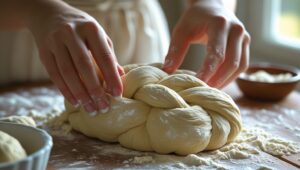
Notes
Equipment
- Stand mixer
- Prep Time: 2hours
- Cook Time: 30minutes
- Category: Cake
- Method: Side Dish
- Cuisine: American
Nutrition
- Calories: 101kcal
- Sugar: 1g
- Sodium: 106mg
- Fat: 1g
- Saturated Fat: 0.4g
- Unsaturated Fat: 0.2g
- Trans Fat: 0.001g
- Carbohydrates: 19g
- Fiber: 1g
- Protein: 3g
- Cholesterol: 9mg
Simple Dough, Beautiful Shape
Braiding bread might look complex, but it is easier than you think. Once you get the feel of shaping three dough ropes, it becomes second nature. The dough used in this recipe is soft, smooth, and forgiving. With a little practice, your loaves will look just as good as they taste.
Just like Greek koulourakia, which uses similar shaping, braided bread brings together taste and texture with artistry.No special event is required to enjoy baking this bread.All you need is a quiet hour, a warm oven, and a reason to make something beautiful with your hands.
How to Make Braided Bread Step-by-Step
From Mixing to Kneading, Here’s How to Start
Braided bread starts with a rich, tender dough as its foundation.In this recipe, warm milk and a bit of sugar activate the yeast, helping the bread rise into a light, fluffy texture. Once the yeast is bubbly, it’s time to mix it into the flour and salt. Add olive oil and another cup of warm milk, then use a stand mixer or your hands to form a firm, pliable dough.
The key to success is patience. If your dough feels sticky, sprinkle in more flour one tablespoon at a time until it pulls away from the bowl. Mix for at least 5 minutes. Then transfer the dough to a floured surface and knead gently for a few minutes. This gives the bread structure and elasticity. Let it rise for an hour in a warm spot, covered with a towel.
After the first rise, knead again and let it rest for 30 more minutes. This double rise builds flavor and texture. Divide the dough into six equal parts. You’ll be working with three pieces per loaf, which makes two braided loaves in total.
For anyone new to baking, this dough is very forgiving. It’s similar in ease to this cottage cheese cookie dough, which also holds its shape well and is beginner-friendly.
How to Braid Like a Pro Without Stress
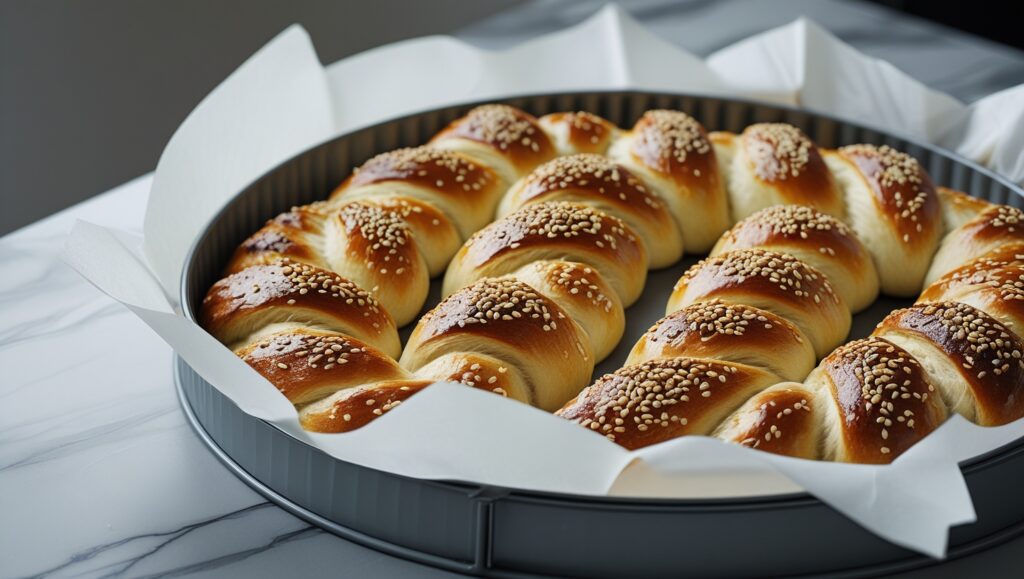
Now comes the fun part: braiding. Take each of your six dough portions and roll them into ropes about 16 inches long. Use three ropes for each loaf. Lay them side by side and pinch the top ends together to secure them. Begin crossing the outer rope over the center one, switching sides with each movement, just like braiding hair. Keep your braids loose and even. Once you reach the bottom, pinch the ends and gently tuck them underneath.
Do the same with the remaining three ropes to form your second loaf. Place both loaves into a parchment-lined 9×13 pan. Use a strip of parchment between the loaves to keep them separate. Brush the dough with a beaten egg mixed with water. If you like, sprinkle sesame seeds over the top for added texture and flavor.
Before you bake, place an oven-safe dish filled with water on the lower rack. The steam will help create a shiny, golden crust. This technique is similar to the one used in recipes like ube crinkle cookies, where moisture plays a key role in achieving a beautiful finish.
Bake your bread at 385°F for about 30 minutes. The tops should be golden and firm to the touch. A gentle tap should produce a hollow sound, signaling they’re perfectly baked.
If your braids look tight or your bread splits while baking, don’t worry. That usually means the dough was shaped a little too firmly. With each bake, you’ll learn how much tension to use and how to keep the shape relaxed but structured. Braiding becomes easier with practice, and every loaf is a chance to get better.
Flavor Variations and Global Braided Bread Traditions
Sweet, Savory, and Seasonal Twists
One of the best things about braided bread is how easily it adapts to flavor. You can keep it simple or add a creative twist with ingredients already in your pantry. For sweet versions, try mixing in cinnamon, cardamom, or orange zest. A bit of honey or brown sugar in the dough adds warmth and depth, perfect for holiday brunch.
For something savory, consider adding chopped herbs like rosemary or thyme. You can also fold in shredded cheese or roasted garlic before braiding. These ingredients blend beautifully into the dough and fill your kitchen with rich, cozy aromas as the bread bakes.
Sesame seeds on top are a classic choice, but poppy seeds, everything bagel seasoning, or even sea salt flakes work just as well. If you enjoy baking cookies with flavor-forward touches, like these Mexican cinnamon cookies, you’ll appreciate how spices and toppings elevate a simple loaf.
Another option is to incorporate natural color and subtle sweetness using ingredients like ube or sweet potato. Ube especially lends a vibrant purple color and smooth, creamy texture, reminiscent of the taste in ube crinkle cookies.
These additions do more than taste good. They create loaves that feel festive, personalized, and made with intention. Whether you’re baking for guests or simply for yourself, a flavored braided bread always feels special.
Bread Traditions Across Cultures
Braided bread is a technique seen around the world, and each version tells a story. In Jewish culture, challah is a staple at the Sabbath table. This rich bread is made with eggs and often finished with a sprinkling of sesame or poppy seeds.The braiding pattern often holds symbolic meaning, such as unity and connection.
In Greece, tsoureki is flavored with orange zest and a sweet spice called mahleb. It is traditionally served at Easter and often includes red-dyed eggs tucked between the braids. This bread reminds me of the joy behind koulourakia, another Greek favorite that is twisted by hand and baked until golden.
Eastern Europe brings us kalach, a circular braided bread that represents eternity. Some versions are braided in spirals or rings and used in celebrations like weddings or holidays.
Other cultures add unique flair. In Central and South America, you may find sweet braided breads filled with guava or dulce de leche. In the Philippines, soft enriched loaves like ensaymada or pan de leche may not be braided, but they share a similar richness and importance in family gatherings.
Braiding techniques might differ, but the spirit behind them stays the same. Each loaf reflects time, care, and the desire to bring people together. That’s what makes braided bread more than just a recipe. It’s a connection to heritage and community, baked into every fold.
Serving Suggestions and Storage Tips for Braided Bread
How to Serve Braided Bread at Any Meal
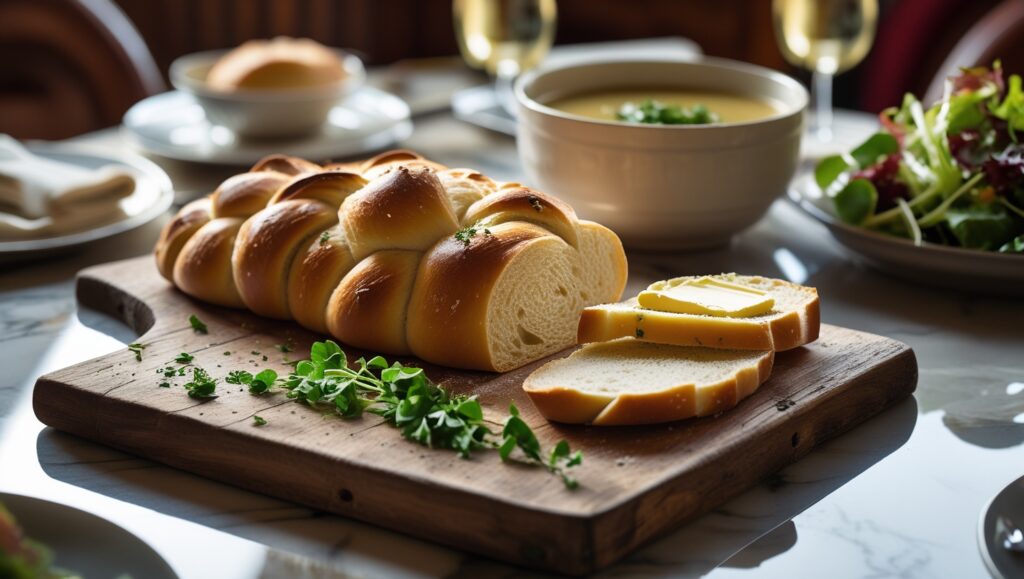
Braided bread is one of the most versatile baked goods you can make. Its soft interior and golden crust make it a beautiful centerpiece for nearly any meal. You can slice it thick and serve it warm with butter, or tear off pieces at the table for a more rustic, hands-on experience.
For breakfast or brunch, pair it with whipped cream cheese, citrus honey butter, or a fruit preserve. It also goes well with a cup of coffee and a few Greek pastries on the side. The natural sweetness in the bread makes it a great match for salty or creamy spreads.
At lunch or dinner, serve it with soups, stews, or hearty salads. Its texture holds up well when dipped into broth or olive oil, especially when infused with garlic or herbs. You can even turn thick slices into sandwiches.Pair it with roasted veggies, sliced turkey, or a generous spread of pesto.
For holidays or special occasions, braided bread adds elegance to any spread. Arrange slices on a platter next to cheeses, cured meats, or a fresh green salad. If you’re already planning to make a baked dessert like this American cake recipe, a fresh loaf of braided bread balances out the menu with something savory and simple.
This bread invites sharing. Place it in the center of your table, and let people pull off what they need. It brings comfort and ease to gatherings, whether large or small.
How to Store and Keep It Fresh
Once cooled, braided bread should be stored properly to keep its texture soft and the crust slightly crisp. Wrap the loaf in foil or parchment paper, then place it inside an airtight bag or container. Keep it at room temperature for up to three days.
Avoid storing the bread in the refrigerator, as that tends to dry it out. Instead, freeze any leftover slices. Wrap each slice in parchment or wax paper, place them in a freezer-safe bag, and freeze for up to two months.
To reheat, place the slices in a 325°F oven for 8 to 10 minutes until warmed through.For a softer result, wrap them in foil before baking. You can also toast individual slices lightly for a crisp edge. If you’ve added ingredients like cheese or garlic, reheating will bring those flavors back to life.
If your loaf starts to dry slightly, turn it into a sweet or savory bread pudding, or cube it and toast for homemade croutons. Bread this good shouldn’t go to waste. Much like the dough in cottage cheese cookie dough, it holds up well in multiple forms, even after baking.
Whether you’re enjoying it fresh from the oven or days later, braided bread remains one of the easiest and most rewarding breads to bake and share. It offers flexibility, flavor, and a touch of something beautiful with every slice.
Conclusion
Braided bread combines more than just flour and yeast, it weaves in tradition and care. It holds memories, tradition, and the kind of comfort that comes from baking with your hands. Whether you’re shaping a simple three-strand loaf or exploring sweet and savory twists, the process is just as meaningful as the result.
This recipe is an invitation to slow down, get creative, and share something beautiful from your kitchen. With a little practice, you’ll find that braiding dough becomes second nature. You can serve it warm at brunch, enjoy it with dinner, or gift it as a thoughtful homemade treat.
So gather your ingredients, preheat the oven, and enjoy the rhythm of mixing, kneading, and braiding. There’s a reason breads like this have stayed with us for generations. They nourish the body and the spirit—and there’s always room at the table for one more slice.
For more recipe follow me in pinterest
Frequently Asked Questions About Braided Bread
What are braided breads called?
Braided breads are often referred to by specific names depending on the culture or ingredients. Common types include challah, which is a traditional Jewish egg bread, and tsoureki, a Greek braided loaf made with sweet spices. In general, any bread that uses strands of dough woven together before baking can be called braided bread.
What is a braided bread that starts with B?
One well-known braided bread that starts with the letter B is “brioche.” Although not always braided, brioche dough can be shaped into braids for an enriched and buttery loaf. Another example is “breadsticks” shaped into braids for visual appeal, especially in Italian or fusion recipes.
What is a braided bread that starts with C?
Challah is a classic braided bread that starts with C. It is made with eggs, flour, water, sugar, and yeast, and is typically braided before baking.Challah holds a special place in Jewish cuisine, traditionally enjoyed during Shabbat and festive holidays.
Can I braid regular bread?
Yes, you can braid regular bread dough as long as it is firm enough to hold its shape. While enriched doughs like those in challah or brioche work best, standard white or whole wheat bread doughs can also be braided. Just make sure the dough is not too wet or sticky, which can make braiding difficult.

